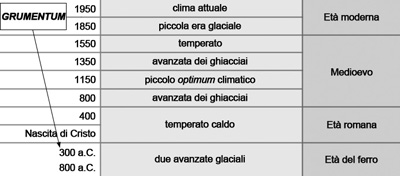| Climate during Roman age |
by Antonio Priore
The climate in Roman age was Mediterranean, coming from the passage of a cold cycle tending to a subsequent phase of heating and a consequent moving back of the glaciers happened between 300 B.C. and 400 B.C. And this is exactly the historical period when the ancient housing nucleus of Grumentum was created and developed. The basically mild climate was a factor of undisputed importance for the development of ancient Grumentum, due to close links between climatic conditions and natural resources (fauna and flora). In fact the presence of numerous animal sedentary species on the territory assured protein supplying to the populations who settled in these places. Since Roman age it was actually reported the presence of bears, often in competition with humans, insomuch as from this moment it’s noted the decrease of specimens and the subsequent disappearance of this plantigrad. It is also documented the presence of many other species such as deer, roe deer, golden eagle and wild boar.
The natural habitat of Roman period results characterized by an alluvial plain partially incised, notched among rather high mountains, and by a system of timber tree woods connected each other by bushy areas; human habitat was on the other side characterized by urban areas, houses and roads very small compared to the territory, well delimited and perfectly held in the natural environment. It is also necessary mention the hill on which stands Grumento Nova, also archaeological site of a less-known structure located near the Mother Church (762 meters above sea level), which could be used as sighting and communication point for any unwanted approaches to the Roman outpost, because it provided the possibility to observe the surrounding area all over the places.
To this end it’s important to mention the work of Livy, who described Roman military maneuvers used to chase away Carthaginian invaders. It is exactly the morphological compliance of the territory that gave the opportunity to look down from the high of the hill just described each movement of the enemy, allowing the Romans to turn around the enemy without being seen. In conclusion, so it’s possible to assert that was exactly the morphological and environmental shape of the period that allowed this Roman outpost to settle and grow, differentiating by vitality and urban organization; the numerous natural elements permitted to supply food and water, then supplied the energy for heating and defending and offered raw materials for the construction of artifacts (stone and wood), even if, from careful analysis of the structures preserved during the time, there is the awareness that some materials of great value came also from other places in Mediterranean area.
Bibliografia
Copyright text and pictures (where there aren’t other references) by Antonio Priore |




 In southern Italy, during the
In southern Italy, during the  The botanical aspect was characterized more or less by the species currently present, of course with a larger areal extension. The most important particular that distinguishes the two periods, the current from the Roman one, is beyond all doubt the extension, of Mediterranean maquis, chestnut trees, oak woods that now can be seen just in some clearly defined areas of the Upper Agri Valley, such as Maglie wood. The permanent presence of man therefore has certainly determined a change of places, forasmuch as forests were the most important energy supplier at the time (about this question see also the
The botanical aspect was characterized more or less by the species currently present, of course with a larger areal extension. The most important particular that distinguishes the two periods, the current from the Roman one, is beyond all doubt the extension, of Mediterranean maquis, chestnut trees, oak woods that now can be seen just in some clearly defined areas of the Upper Agri Valley, such as Maglie wood. The permanent presence of man therefore has certainly determined a change of places, forasmuch as forests were the most important energy supplier at the time (about this question see also the 